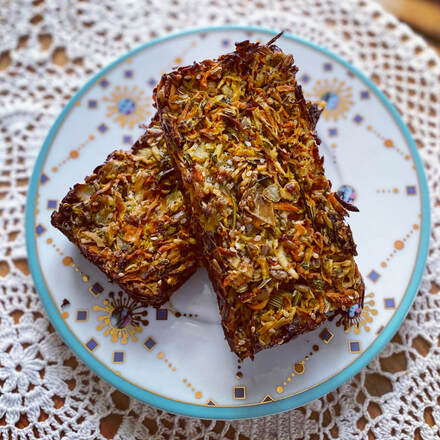The ParsnipParsnips are a cream colored, conical shaped root vegetable prized for their naturally sweet and nutty anise flavor. In Europe, parsnips were a source of sugar long before cane and beet sugars - that's how sweet they are. And when prepared correctly, they can just as easily serve as a sweet snack as well as something savory. Given their rather sweet nature, it's a good thing then that they are loaded with fiber, low in fat, and are a good source of folate, vitamin C, and manganese (if eating 1 cup or more/occasion) as well. These nutrients are essential in maintaining a healthy immune system, good for heart and gut health, healing wounds, and building bones. How I Use ParsnipsTry some of the following techniques and flavor pairings to increase your vegetable intake. Techniques: bake, blanch, boil, braise, deep-fry, fry, grate, grill, mash, pressure-cook puree, roast, simmer, steam Flavor affinities: apple, butter, carrot, celery root, Parmesan, chives, cinnamon, coriander, curry, dates, garlic, ginger, honey, leeks, lemon, lentils, maple, mint, mushrooms, mustard, nutmeg, onion parsley, other root vegetables, potatoes, pumpkin, thyme, turmeric A few favorite combos: parsnip + carrots + fennel + sweet potatoes parsnip + lentil + curry parsnip + chestnut + mushroom + parmesan Parsnip Seed Loaf: The RecipeNigel Slater, a highly-regarded food author (and one of my personal favorites) published a fantastic book called The Christmas Chronicles in 2017. In it, he describes his love of winter weather - the way the cold air rushes through his lungs, and the often-overlooked bounty that comes in cold-weather climates. Every year, when the weather grows cold and Minnesota winter takes hold, I am inspired to embrace the season the way he does - sub-zero temperatures and frigid winds are something to be celebrated, not shunned. This year, I decided to create my own version of his parsnip loaf, fine-tuning it using ingredients from my own backyard, and giving it a healthier spin - this recipe is loaded with healthy fats, plant-based protein, and homemade pear applesauce from the pear tree growing just outside my bedroom window. This dish is especially appealing on these cold, wintery days served with a healthy serving of mushroom gravy. This recipe relies on the backbone of parsnips sweetness to deliver you a vegetarian mainstay in your recipe repertoire. Makes 1 larger loaf or 3 small loaves INGREDIENTS: 500g (~5 oz) parsnip, grated 250g (~2.5 oz) carrot, grated 3/4 c pear applesauce 3 tablespoons avocado oil 1 large onion, minced 4 cloves garlic, minced 1/2 tsp dill seed 2 tbsp sesame seeds, toasted 1 tbsp fennel seeds, toasted 3 tbsp sunflower seeds 2 tbsp poppyseeds 1 tbsp chopped thyme 2 large eggs, whisked DIRECTIONS: Sauté parsnip and carrot in 2 tbsp oil for 5 minutes, then add pear applesauce. Remove from pan and place in a large mixing bowl. Add remaining oil and sauté onion until translucent, then add garlic and sauté for another 1-2 minutes. Remove from pan and add to parsnip, carrot mix - add salt and pepper to taste. Combine remaining ingredients (seeds, thyme, and eggs) in the mixing bowl and spoon into prepared loaf pan(s). Bake at 400F for 40-50 minutes until cooked throughout. Bonus: Gardening TipsMany farmers and gardeners wait as the weather cools for a few frosts before they harvest their parsnips, as the parsnips become sweeter when they stay in frozen ground - they can be left in the ground all winter long when covered with a thick layer of mulch. As soon as the ground thaws in the spring, they should be harvested for optimum sweetness. If you're looking to plant parsnips, visit the Farmer's Almanac for more detailed information. It's a wonderful resource for planting other crops in other seasons as well. Hungry for more? Check out the article on the parsnip's other (more popular) relative, the carrot: CARROTS: AN EXCITING AND DELICIOUS LOOK AT THE WORLD'S SECOND FAVORITE VEGETABLE
0 Comments
|
SEARCH ARTICLES BY CATEGORYAll Dough & Noodle Main Nosh Sauce Or Spread Skin Soups & Stews Spices Sweets READ NEXTMOST POPULAR |
Copyright © 2015 Ranelle Kirchner - All Rights Reserved - Designed by Adrian Daniel Schramm
